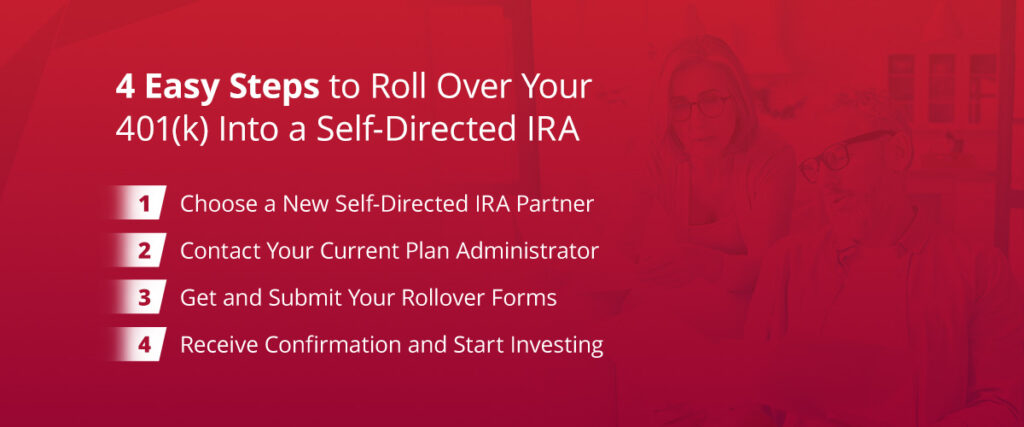
Employer-sponsored 401(k) plans are a common benefit for employees to encourage long-term savings, but these plans have drawbacks. Chief among them are the options you have for the funds during employment and what you can do with them if status changes occur. When you don’t want the potential financial consequences of withdrawing funds from your plan, there is a better option.
Self-directed IRAs are available for both tax-deferred and tax-free funding, making them an excellent solution for qualified money that can continue to grow under favorable tax treatment. You can roll your 401(k) into a self-directed IRA, simultaneously complying with IRS rules and unlocking your retirement savings’ full potential.
Fundamentals of Rolling a 401(k) Into a Self-Directed IRA
Two types of IRA rollovers exist under the Internal Revenue Code — direct rollovers and indirect rollovers. Both are reportable transactions to the IRS.
A direct rollover occurs when money moves from a non-IRA qualified account to an IRA or other account without ever coming directly into your possession, such as from a 401(k) to an IRA. This method is generally the best solution to avoid any tax complexities that can arise and is the approach we typically recommend. An indirect rollover happens when you withdraw and handle the funds from a qualified account. The IRS allows you to redeposit the money you receive back into a qualified account for up to 60 days to avoid certain tax consequences.
Note that these differ from an IRA transfer, which is the direct movement of assets from an existing IRA with one trustee to another qualified account. This transaction is not reported to the IRS.
4 Easy Steps to Roll Over Your 401(k) Into a Self-Directed IRA

Follow the steps below to roll your 401(k) into a self-directed IRA.
1. Choose a New Self-Directed IRA Partner
First, you’ll need to choose the institution you’ll partner with to act as your IRA administrator. These companies help you establish and maintain your self-directed IRA in compliance with IRS regulations. They typically work with an IRA custodian, an organization that holds and reports on qualified retirement assets on behalf of your IRA.
Questions to consider to help you choose the right administrator for you include:
- How long has the administrator been in business?
- What is the average level of expertise for their team members?
- What services do they provide?
- What are their fees?
- What is their reputation within the industry and with current or former customers?
Once you’ve chosen the best partner to meet your needs, you can open your new self-directed IRA.
2. Contact Your Current Plan Administrator
Every plan administrator has different policies and form requirements for rollovers. The best solution is to be proactive and contact them first to find out what they need. For example, many administrators require a letter of acceptance from the organization receiving your funds.
Some plans may also require you to initiate the sale of your investments personally rather than accepting the written instructions on the receiving firm’s rollover forms. You can typically do this over the phone so your assets are cash-based and ready for rollover once the current administrator has the documentation they need.
3. Get and Submit Your Rollover Forms
When you’re ready to convert your 401(k) into a self-directed IRA with a direct rollover, you’ll need to fill out and submit rollover forms. These forms detail information about your current account and tell the existing administrator where and how to send payment on your behalf. Typical information you’ll need to complete this step includes a recent 401(k) statement that shows:
- Your full name and account number
- The type of qualified account
- The approximate value
- The plan administrator’s contact information
If the administrator requires you to complete their own forms, ensure you have your new self-directed IRA account number and contact details for your new administrator available.
4. Receive Confirmation and Start Investing
Your administrator typically sends confirmation after your account is funded. Once you receive that, you can start considering the different investments possible in your self-directed IRA and which ones will work for you.
FAQs
The following answers are an excellent starting point for learning more about 401(k) rollovers to self-directed IRAs. Please reach out to our team if you have additional questions or need more information.
Why Roll Your 401(k) Into a Self-Directed IRA?
The primary benefit of a self-directed IRA is the investment freedom you enjoy that employer-sponsored plans and conventional IRAs don’t provide. You can choose from a wider range of asset classes, allowing you to diversify your portfolio beyond traditional mutual funds, stocks and bonds. That means you can put your money to work your way.
Consolidating your long-term savings is another reason to consider a 401(k) rollover into a self-directed IRA. You’ll have a more holistic view of your retirement portfolio in one central location and the convenience of managing your qualified assets with one trusted partner.
Will I Have to Pay Taxes on My 401(k) Rollover?
A direct rollover from a 401(k) to a self-directed IRA is generally a nontaxable transaction since you don’t take possession of the money. There is one important exception to note — the funds must move between the same type of qualified account to prevent a taxable event. For example, money from a traditional 401(k) plan must go into a traditional IRA and funds from a tax-free Roth 401(k) to a Roth IRA. Moving from a traditional 401(k) to a Roth IRA is considered a taxable Roth conversion.
Under the indirect rollover rules, the plan administrator typically withholds 20% in taxes before issuing you a check for the remainder. You can add personal funds to your indirect rollover to replace that 20%, deposit the entire amount to another qualified account within 60 days and claim the 20% withholding as taxes paid on your individual tax return to make the transaction tax-free. Similar to a direct rollover, moving funds from a traditional tax-deferred plan to a tax-free Roth IRA is a taxable event.
When Am I Eligible to Roll Over My 401(k) to a Self-Directed IRA?
Several events or changes in your personal status can result in eligibility to initiate a rollover from a 401(k) to a self-directed IRA, including:
- Voluntary or involuntary termination of employment
- Discontinuation of plan sponsorship by your employer
- Retirement
Some plans may also allow in-service withdrawals from your 401(k) that you can roll over. Your current administrator is the best source of options allowable under an existing employer-sponsored account.
Open an Accuplan Account to Start Your Rollover

Ready to roll over your 401(k) plan with the experts? We’re ready to help! Accuplan Benefits Services is a trusted self-directed IRA administrator that’s been helping investors like you with long-term financial strategies since 1985. Our team members boast an average of 15-plus years of industry experience, giving them deep expertise to help guide you best. We simplify the process with easy digital account setup and transparent pricing.
Open your account online to start your rollover, or call our experts at 888-897-1109 with questions.
Disclaimer: Our information shouldn’t be relied upon for investment advice but simply for information and educational purposes only. It is not intended to provide, nor should it be relied upon for accounting, legal, tax or investment advice.